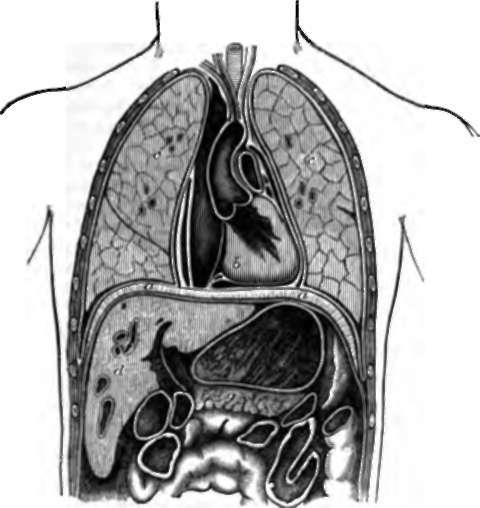100. The Expansion And Diminution Of The Chest In Respiration
Description
This section is from the book "Animal Physiology: The Structure And Functions Of The Human Body", by John Cleland. Also available from Amazon: Animal Physiology, the Structure and Functions of the Human Body.
100. The Expansion And Diminution Of The Chest In Respiration
The Expansion And Diminution Of The Chest In Respiration affects the whole thoracic cavity, containing the heart and great blood-vessels as well as the lungs. It may, therefore, rise and fall are comparatively slight, that only in deep inspirations is the upper end of the bone raised at all, and that while in the best formed chests its lower end moves somewhat upwards and forwards in ordinary breathing, there are many chests in which there is little or no movement of the breast bone at all. The enlargement of the chest, by movement of the ribs, in quiet breathing, is therefore principally effected by raising the lateral arches or hoops formed by large ribs, so as to bring them into the positions previously occupied by smaller ribs above them; and in deep inspiration these are further elevated by the first pair of ribs being themselves raised by muscles descending from the neck. The elevation of the first pair of ribs increases the capacity of the thorax considerably; for although those ribs are short, and embrace but a small portion of lung, their elevation involves the additional raising of those below.

Fig. 78. Vertical Transverse Section of Chest and Stomach, to show the arched form of a, a, the diaphragm; b, the heart; c, c, lungs; d, liver; e, stomach; f, spleen; g, pancreas. The reflexions of the pericardium and pleurae round the heart and lungs are represented. Altered from Luschke.
If a finger be placed on the twelfth rib during the fullest inspiration, it will be found that it is scarcely, if at all, raised, that its principal movement is backwards; and the importance of this will be appreciated when it is considered that the thoracic cavity is increased in size by depression of its floor, and would be diminished rather than enlarged by elevation of the attachments of the diaphragm. In fact, the the four lowest pairs of ribs are specially acted on in inspiration by a pair of muscles (serrati postici inferiores), whose office is to pull them backwards and resist their elevation. The backward enlargement of the thorax, particularly in its lower part, is further provided for by the downward and backward direction taken by the ribs as they extend out from the back bone, and is exceedingly important, as it is at the lower and back part of the thorax that the greatest mass of the lungs is situated. That is a fact which ought to be generally borne in mind, not only as pointing out one source of evil from the vicious habit of tight-lacing, but because it is a popular error that in protecting the chest from cold, it is sufficient to accumulate warmth on the fore part. Bronchitis, no doubt, is liable to have its source in exposure to cold by the mouth or in front of the chest, but pneumonia or inflammation of the texture of the lung is more frequently traceable to exposure of the waist; for example, by the evaporation of a shirt damp from perspiration.
Continue to:
- prev: 98. The Main Air Tube, The Trachea Or Windpipe
- Table of Contents
- next: 102. The Muscles By Which The Ribs Are Moved
